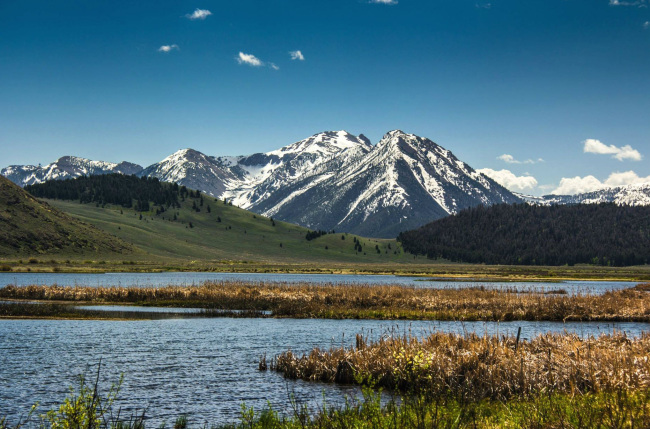Photo: George Jordan, USFWS
In what was undoubtedly one of the most bizarre attempts to “save” a handful of lake grayling, Biden’s U.S. Fish and Wildlife Service, Montana’s Department of Fish, Wildlife and Parks, and Montana Trout Unlimited tried to throw the Wilderness Act under the bus by totally ignoring its legal protections against “trammeling” Wilderness Areas. Thanks to the Alliance and our co-Plaintiffs, they were halted by a federal court injunction and the Fish and Wildlife Service withdrew their decision that authorized the project.Had they succeeded, they planned to use a barge to pound in sheet piling and/or dredge the stream feeding Upper Red Rocks Lake, install a permanent compressor-driven “aerator,” or dig in a mile long trench for a 14” water pipe to the lake from a pond. Having been beaten about the head and shoulders by public commenters, they settled on trenching in the pipeline until halted by the court for blatantly violating the Wilderness Act.
After being thumped in federal court, the Fish and Wildlife Service recently announced that it has abandoned its highly intrusive plan and will now seek other “conservation methods” for Upper Red Rocks Lake’s tiny population of perhaps 70 grayling.
Upper Red Rocks Lake is very shallow – mean depth 6 feet. Because the grayling population has crashed precipitously in the last few years, the Fish and Wildlife Service decided the main threat was, of all things, “winter in Montana.” According to the agencies and Trout Unlimited, snow cover on the lake – and dissolved oxygen depletion thanks to an over-abundance of rotting aquatic vegetation – was the problem they had to address.
Not, mind you, the fact that the feds allowed cattle grazing in the Red Rocks National Wildlife Refuge and Wilderness upstream from the lake that not only broke down streambanks and added sediment, but the excess nutrients from cow manure and urine fertilized the growth of the aquatic vegetation. Not because the state continued to allow Trout Unlimited’s anglers to trample the grayling spawning beds in Red Rocks Creek. And not because irrigation diversions to grow hay for cows meant less water going into the lake in the first place, especially in drought years.
No, this was a grand deception that attempted to equate lake dwelling (adfluvial) grayling with the highly imperiled and quickly disappearing population of river dwelling (fluvial) grayling in Montana’s Upper Big Hole River – the last remaining river-dwelling arctic grayling in the Lower 48 states. Despite the fact that at least 30 of Montana’s lakes have abundant populations of grayling, the agencies and Trout Unlimited painted their violations of the Wilderness Act as necessary to prevent grayling “extinction.”
Ironically, Trout Unlimited and Montana’s Department of Fish, Wildlife and Parks have opposed efforts to list the river grayling for protection under the Endangered Species Act for decades as the population continued to dwindle. Instead, they promoted “collaborative” efforts that have failed miserably. Likewise, despite being sued, the Fish and Wildlife Service refused to face reality and give the river-dwelling grayling the Endangered Species protections needed to halt their extirpation.
The simple fact is that irrigators chronically dewater the Upper Big Hole and neither the feds, the state, nor Trout Unlimited has the courage to address the problem head on – which is, you can’t save cold water fish by leaving a trickle of hot water in the river. Case in point, last year the Upper Big Hole was running at 5 cubic feet per second, meaning lethal temperatures for grayling and trout that shut down the river to fishing. Yet, the irrigators got to “make hay while the sun shines” as the rest of us watch our native grayling and wild trout disappear thanks to federal and state managers and supposed “advocates” who are too timid to actually stop the chronic dewatering of this once world-famous river.
There was no scientific evidence that this project would have helped the grayling in Upper Red Rocks Lake. In fact, in blatant violation of both the National Environmental Policy Act and the Wilderness Act, the Fish and Wildlife Service actually installed a compressor and aerator in the lake last winter that failed to raise dissolved oxygen levels.
Given the well-documented impacts to grayling from water diversions for irrigation, livestock grazing trampling the banks of the Big Hole and its feeder streams, and continued sport fishing in their limited spawning streams, it’s clearly time for the Fish and Wildlife Service, Montana Fish Wildlife and Parks, and Trout Unlimited to drop their opposition to providing Endangered Species Act protections to the tiny remaining fluvial population in the Big Hole River.
We appreciate the Fish and Wildlife Service withdrawing its bad decision after we beat them in court. But if the Fish and Wildlife Service, Montana Fish Wildlife and Parks, and Trout Unlimited truly want to recover arctic grayling, they need to take the next step and get the river dwelling grayling Endangered Species Act protection instead of posturing to “save” a handful of non-endangered lake grayling.
Please consider supporting our efforts. We are a small group but we win more than the big groups.
Mike Garrity is the executive director of the Alliance for the Wild Rockies.
